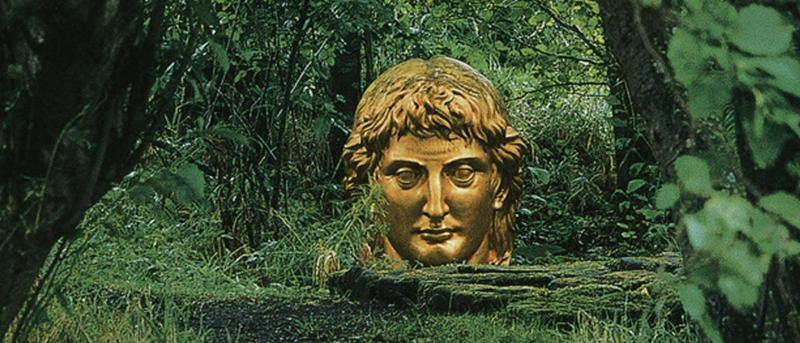Gardens of the Gods: Myth, Magic and Meaning
Gardens of the Gods: Myth, Magic and Meaning
It seems natural that people should imagine paradise as a garden. For most of us, wilderness is too stark, too threatening to be entirely welcoming, while the purely human landscape of the city often seems lifeless. The garden, on the other hand, strikes a perfect balance between nature and nurture, between the wild and the tame. It is not surprising, then, that the very word paradise is originally derived from the Old Persian pairidaeza, which means “garden.”
In this engaging work, Christopher McIntosh, one of the most erudite writers on esotericism today, investigates the many dimensions the garden has taken on in the human imagination. To many creators of this most exquisite form of agriculture, McIntosh reminds us, “gardens were—or are—not merely places of beauty but places of meaning.” As he goes on to show, many cultures regard gardens as means of communication much like sacred buildings, and possessing their own language of correspondences. Indeed, McIntosh’s appendix on the symbolism inherent in plants (yew and cypress symbolize death; the fig, sexuality) is one of the most valuable parts of this book.
As Gardens of the Gods explains, the primordial garden was a microcosm of the world. The Sumerian Epic of Gilgamesh, dating from the third millennium BCE, describes paradise as composed of four rivers radiating out in the four directions from a sacred center. This is much like the account of Eden in Genesis (and may well be the source of it). Not coincidentally, it resembles a mandala, and this pattern went on to become a standard plan for Islamic gardens.
Gardens of the Gods is perhaps at its most informative in its discussion of the Renaissance garden. While there was some interest in the subject in the Middle Ages (a German monk named Walafrid Strabo wrote a treatise on it in the ninth century), it was only with the rebirth of the Greco-Roman sensibility in the fifteenth century that the garden came into its own as an art form in the West. McIntosh argues, quite plausibly, that Pagan images appear so abundantly in gardens of that period and later because “the deities of the ancient world were, to some extent, personifications of natural forces and therefore at home in a natural environment.”
One of the most fascinating sections of Gardens of the Gods explores the Hypnerotomachia Poliphili, “Poliphilo’s War of Sleep and Love,” an enigmatic romance written by Francisco Colonna and published in 1499. The Hypnerotomachia, whose meaning has never been entirely deciphered, contains a long allegory of Poliphilo’s search for his beloved Polia in a rich and bizarre symbolic landscape. McIntosh quotes the Italo- Romanian Princess Emanuela Krezulesco-Quaranta, who argues in her book Les jardins du songe (“Gardens of the Dream,” a work that has never been published in English, though it has attracted a cult following in certain esoteric circles) that the Hypnerotomachia is an allegory of an initiatic journey.
Whether or not that is so, the Hypnerotomachia influenced a number of classic Renaissance gardens in Italy, and also possibly the one at Versailles. As McIntosh goes on to say, Versailles (which “smacks of folie de grandeur, and yet in its own way…is magnifi- cent”) is itself a grandiose allegory of the splendor solis, the splendor of the sun—appro- priately for a creation of Louis XIV , the Sun King (Louis himself composed a brief guide to the gardens at Versailles).
McIntosh takes in a wide swath of the world in his survey, from Persia, China, and Japan to eccentric modern-day creations such as Ian Hamilton Finlay’s Little Sparta in the Lanarkshire hills of Scotland, which is punctuated by little scraps of haiku-like poetry (“One orange arm of the world’s oldest windmill”) and which serves as a tool in its creator’s self-proclaimed war against the “secular terror.” There is also Niki de Saint Phalle’s Tarot Garden in Tuscany, a six-acre marvel displaying figures corres- ponding to the Tarot’s Major Arcana, including “the Hermit, an austere form in mirror glass with the head of a space alien,” and “the Devil, a sinister, bat-winged apparition with a phallus shaped like a gold claw.”
As fascinating as all this is, it would be somewhat academic if McIntosh had not concluded his book with chapters suggesting how to go about designing one’s own garden of meaning. His advice is both sensible and down-to-earth, and his examples do not require the grandiose budgets of the nouveaux riches but are simple specimens such as one might create behind an ordinary English house.
Gardens of the Gods is, in short, a learned and exquisite guide to a subject that is too often treated only in the most humdrum way. Reflecting on the book, I find myself wondering what McIntosh would have to say about other configurations of sacred space—Damanhur, for example, the weird underground “Temple of Mankind” built in secrecy underground in the Italian Alps. Perhaps in future works he will take his sharp but affectionate eye on other forms by which humans make the material an image of the immaterial.
Richard Smoley
Be the first to post a message!
